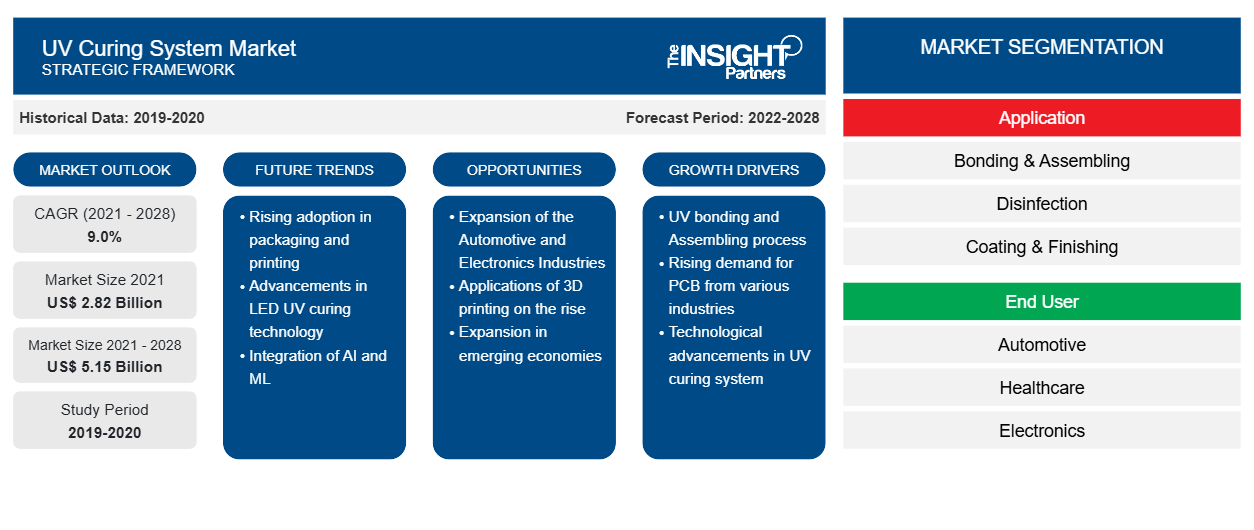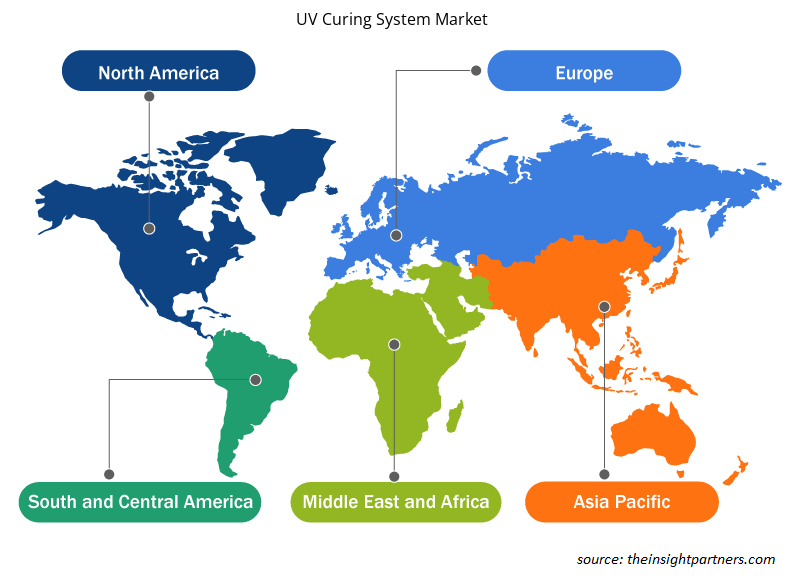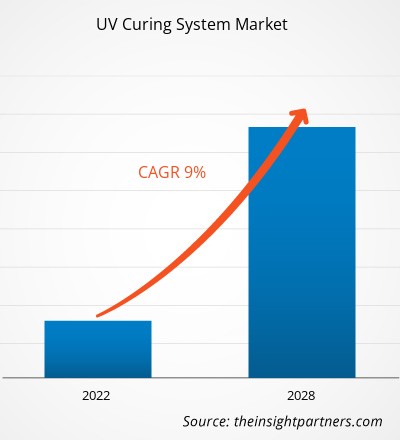The UV curing system market was valued US$ 2,817.2 million in 2021 and is expected to reach US$ 5,153.2 million by 2028 with a CAGR growth rate of 9.0% during the forecast period from 2021 to 2028.
UV curing is a method of drying inks, adhesives, and coatings. The UV curing system is a relatively old technology and has been used for a long time. The old UV curing systems used mercury lamps for curing. However, with advancements in technology and the increasing effect of mercury lamps on the workers and environment, UV LEDs are used as a source in the curing systems. The curing method is widely used in many industry verticals, such as automotive, healthcare, electronics, aerospace, graphic & art, and wood coatings. With demand rsising for bonding & assembling, printing, coating, and other process in aforesaid industries, the demand for systems will continue to rise, which in turn will proper the growth of UV curing system market.
The major stakeholders in the global UV curing system market ecosystem include component manufacturers, UV curing system manufacturers, government agencies and regulatory bodies, and end users. Component and hardware providers offer numerous parts and components to UV curing system manufacturers. Any impact on these component manufacturers directly impacts the UV curing system producers as the whole production process is dependent on timely supply of the components. The broad supply chain of UV curing system plays a huge role in boosting the growth of UV curing systems, and thus impacting the Uv curing system market growth.
Customize This Report To Suit Your Requirement
You will get customization on any report - free of charge - including parts of this report, or country-level analysis, Excel Data pack, as well as avail great offers and discounts for start-ups & universities
UV Curing System Market: Strategic Insights

- Get Top Key Market Trends of this report.This FREE sample will include data analysis, ranging from market trends to estimates and forecasts.
You will get customization on any report - free of charge - including parts of this report, or country-level analysis, Excel Data pack, as well as avail great offers and discounts for start-ups & universities
UV Curing System Market: Strategic Insights

- Get Top Key Market Trends of this report.This FREE sample will include data analysis, ranging from market trends to estimates and forecasts.
Impact of COVID-19 Pandemic on UV Curing System Market Study on APAC region
The limitations imposed by several governments across the region to control the spread of COVID-19 during the initial time frame of the outbreak (Q1 2020) has severely affected the production process due to the restriction of a limited workforce in industries such as automotive, and electronics. Consumer electronics and automotive are the significant sectors that contribute towards the growth of the UV curing system market in the region. Owing to job loss or salary cut, buying capacity of the customer decreased substantially. The reduced buying power impacted the sales of consumer electronic across the region. The Indian automotive industry suffered a daily loss of US$ 31,164 million approximately during 2020 according to Automobile Industry Associations. Similarly, according to the World Economic Forum the car sales in China dropped by 92% in the first half of February 2020. However, as the economies re-opened and industries began their operations, the requirement for UV curing system from various end-users has started to grow gradually. Also, with ease in earlier restrictions, companies can now work with high workforce capacity. The downturn inindustrial activities have negatively impacted the UV curing system market.
UV Bonding & Assembling Fuel Growth of UV Curing System Market
UV bonding and assembling is a process used for glass, metal, and plastic bonding purposes and assembly of printed circuit boards (PCB). The bonding used in this process uses ultraviolet sensitive adhesives that are applied to products and exposed to energy from UV curing lamps for curing. UV curing makes the process faster, more flexible, long-lasting, and environment friendly than other processes.
UV LED curing method reduces the emissions of the volatile compounds. Therefore, the demand for the UV curing systems using LED increased in various verticals, which is driving the growth of the market. However, limited depth curing may act as a restraint in the growth of the UV curing system market.
The rise in demand for PCB from various industries, such as electronics and automotive, influences the rise in demand for PCB across the globe. Manufacturers of consumer electronics, wearable gadgets, such as smartwatches that contain chips and flexible sensors, are seeing new prospects owing to the Internet of Things (IoT). Breakthroughs in device design and manufacturing technology are having a favorable impact on PCB production across the world. Thus, the rise in PCB production is propelling the demand for bonding & assembling processes from the manufacturers. Additionally, demand for glass bonding is expected to increase in end-use sectors such as electronics, furniture, and transportation, which would fuel the market growth for the UV bonding and assembling application segment during the forecast period.
The other segment in the UV curing system market includes food & beverage, manufacturing, packaging, wood and others. UV curing system is used in these applications for different purposes such as bonding & assembling, disinfection, and printing. With the advanced features provided by the UV curing systems over the conventional curing system is leading various companies to opt for this system as the curing method for faster drying. These reasons will support the growth of UV curing systems currently and in the coming years. For instance, UV curing system in the food and bev verage is industries is increasing used for disinfecting contaminated ground and surface water. They are also actively used for treating food and packaging material that pass through conveyor belts to ensure safety of product before reaching the ultimate consumer. These factors are propelling the demand for UV curing systems among the food a& beverage industry over the years. Additionally, the rise in adoption of UV curing systems for bonding applications across the wood industry owing to its fast dry nature is further propelling the growth of the market.
End User-Based Market Insights
Based on end users, the UV curing system market is segmented into automotive, healthcare, electronics, and others. In the automotive industry, UV curing is mainly used to dry the paints faster and increase the curing speed. Since automobile companies' painting/drying capacity is one of the main blockages in most OEM lines and body shops, UV curing technology provides an outstanding time-saving procedure for the companies. This method is used in various other applications in the automotive industry, such as varnish on the body or scratch-proofing coating on the exterior or interior components, anticorrosion coating on tanks or metal springs, deburring of plastic parts, screen printing on glass panes, and adhesives on trim panels or rear spoilers. For instance, Heraeus Holding uses UV curing to provide various automotive sector services. It offers UV curing costing for headlamp lenses, lighting reflector housing, exterior body components, and underhood components. This increases the use of UV curing in the automotive sector. Therefore, the UV curing system market for the automotive segment is expected to grow in the coming years.
UV LED Curing Association, American Coatings Association, and International LED-UV Association play an influential role in the UV curing system market ecosystem. The COVID-19 outbreak has affected the UV curing system market growth to a considerable extent. The outbreak affected business revenues and global supply chains due to factory shutdowns, temporary closure of borders, and trade restrictions across the globe. However, this market is expected to do well as the situation is coming back to normalcy.
UV Curing System Market Regional Insights
The regional trends and factors influencing the UV Curing System Market throughout the forecast period have been thoroughly explained by the analysts at The Insight Partners. This section also discusses UV Curing System Market segments and geography across North America, Europe, Asia Pacific, Middle East and Africa, and South and Central America.

- Get the Regional Specific Data for UV Curing System Market
UV Curing System Market Report Scope
| Report Attribute | Details |
|---|---|
| Market size in 2021 | US$ 2.82 Billion |
| Market Size by 2028 | US$ 5.15 Billion |
| Global CAGR (2021 - 2028) | 9.0% |
| Historical Data | 2019-2020 |
| Forecast period | 2022-2028 |
| Segments Covered |
By Application
|
| Regions and Countries Covered | North America
|
| Market leaders and key company profiles |
UV Curing System Market Players Density: Understanding Its Impact on Business Dynamics
The UV Curing System Market is growing rapidly, driven by increasing end-user demand due to factors such as evolving consumer preferences, technological advancements, and greater awareness of the product's benefits. As demand rises, businesses are expanding their offerings, innovating to meet consumer needs, and capitalizing on emerging trends, which further fuels market growth.
Market players density refers to the distribution of firms or companies operating within a particular market or industry. It indicates how many competitors (market players) are present in a given market space relative to its size or total market value.
Major Companies operating in the UV Curing System Market are:
- American Ultraviolet
- AMS Spectral UV
- Dymax
- Excelitas Technologies Corp.
- Hanovia-uv
Disclaimer: The companies listed above are not ranked in any particular order.

- Get the UV Curing System Market top key players overview
Players operating in UV curing system market adopt strategies such as mergers, acquisitions, and market initiatives to maintain their positions in the market. A few developments by key players are listed below:
- AMS Spectral UV President Rich Bennett announced the company's return as not only a founder, but as a Platinum Sponsor of Print UV 2022 on March 16-18 at the Wynn Encore.
- Phoseon Technology announced partnership with American Ultraviolet for the advancement of LED curing in all UV curing markets.
In the global UV curing system market is segmented on the basis of application and end user. Based on application, the market is segmented into bonding & assembling, disinfection, coating & finishing, and printing. Based on end users, the UV curing system market is segmented into automotive, healthcare, electronics, and others.
American Ultraviolet, AMS Spectral UV, Dymax Chemical (Shanghai) Co. Ltd, Excelitas Technologies Corp., Hanovia-uv, Heraeus Holding GmbH, Jenton Group, Nordson Corporation, and Phoseon Technology are among the key UV curing system market players considered for the research study. Several players have also been analyzed in this research report to get a holistic view of the global UV curing system market and its ecosystem.
Frequently Asked Questions
What trends are expected to drive the demand for various UV curing system market?
There is an increase in the use of 3D printing in today's market. Many companies are increasingly using this technology for creating a three-dimensional structure for rapid prototyping and additive manufacturing. The UV curing process is based on photochemical reaction, using light instead of heat, which instantly dries and cures the inks. Therefore, with the high adoption of 3D printing in the global market, the market for UV curing is simultaneously growing, and it will continue to increase in the coming years.
Which region dominated the UV curing system market in 2020?
The robust manufacturing industry across the APAC region is significantly driving the APAC UV curing system market. The countries across the region have a huge presence of electronics, automotive and medical equipment manufacturers. UV curing systems are actively utilized across these companies for various applications such as die attachment, wire tacking, pin attachment, and sealing & gasketing products. UV curing solutions are also adopted for coating applications across this industry.
Which application held the largest share in 2020?
UV Bonding and assembling is a process that is used for glass, metal, and plastic bonding purpose, as well as assembly of printed circuit boards (PCB). The bonding used in this process uses ultraviolet sensitive adhesives that are applied on the products and are exposed to energy from UV curing lamps for curing. Using UV curing makes the process fast, flexible, long lasting, and environment friendly in comparison to other process.
Which component is expected to dominate the market in the forecast period?
UV LED-based curing systems have better properties than the other curing systems, such as better abrasion resistance, durability, elasticity, adhesion, and chemical resistance. Hence, the demand for UV LED-based curing systems is increasing over conventional curing systems that use mercury lamps.
What are market opportunities for UV curing system market?
The growing acceptance of UV curing solutions across industries such as manufacturing, food & beverages, wood & glass, electronics, and automotive for various applications—including bonding & assembling, printing, coasting & finishing, and disinfection—is influencing the market players to increase their investment in product innovation and geographical expansion.
What are factors driving the growth of UV Curing System market growth?
UV LED-based curing systems have better properties than the other curing systems, such as better abrasion resistance, durability, elasticity, adhesion, and chemical resistance. Hence, the demand for UV LED-based curing systems is increasing over conventional curing systems that use mercury lamps. These systems also provide a better operational speed of the machine and faster drying of the product. The UV curing systems also reduce the emission of the volatile organic compounds (VOCs) released during painting, coatings, inks, adhesives, and similar materials. Hence, these systems are highly adopted in a wide variety of applications such as furniture, automotive, healthcare, and electronics.
- Historical Analysis (2 Years), Base Year, Forecast (7 Years) with CAGR
- PEST and SWOT Analysis
- Market Size Value / Volume - Global, Regional, Country
- Industry and Competitive Landscape
- Excel Dataset
Testimonials
Reason to Buy
- Informed Decision-Making
- Understanding Market Dynamics
- Competitive Analysis
- Identifying Emerging Markets
- Customer Insights
- Market Forecasts
- Risk Mitigation
- Boosting Operational Efficiency
- Strategic Planning
- Investment Justification
- Tracking Industry Innovations
- Aligning with Regulatory Trends
Yes! We provide a free sample of the report, which includes Report Scope (Table of Contents), report structure, and selected insights to help you assess the value of the full report. Please click on the "Download Sample" button or contact us to receive your copy.
Absolutely — analyst assistance is part of the package. You can connect with our analyst post-purchase to clarify report insights, methodology or discuss how the findings apply to your business needs.
Once your order is successfully placed, you will receive a confirmation email along with your invoice.
• For published reports: You’ll receive access to the report within 4–6 working hours via a secured email sent to your email.
• For upcoming reports: Your order will be recorded as a pre-booking. Our team will share the estimated release date and keep you informed of any updates. As soon as the report is published, it will be delivered to your registered email.
We offer customization options to align the report with your specific objectives. Whether you need deeper insights into a particular region, industry segment, competitor analysis, or data cut, our research team can tailor the report accordingly. Please share your requirements with us, and we’ll be happy to provide a customized proposal or scope.
The report is available in either PDF format or as an Excel dataset, depending on the license you choose.
The PDF version provides the full analysis and visuals in a ready-to-read format. The Excel dataset includes all underlying data tables for easy manipulation and further analysis.
Please review the license options at checkout or contact us to confirm which formats are included with your purchase.
Our payment process is fully secure and PCI-DSS compliant.
We use trusted and encrypted payment gateways to ensure that all transactions are protected with industry-standard SSL encryption. Your payment details are never stored on our servers and are handled securely by certified third-party processors.
You can make your purchase with confidence, knowing your personal and financial information is safe with us.
Yes, we do offer special pricing for bulk purchases.
If you're interested in purchasing multiple reports, we’re happy to provide a customized bundle offer or volume-based discount tailored to your needs. Please contact our sales team with the list of reports you’re considering, and we’ll share a personalized quote.
Yes, absolutely.
Our team is available to help you make an informed decision. Whether you have questions about the report’s scope, methodology, customization options, or which license suits you best, we’re here to assist. Please reach out to us at sales@theinsightpartners.com, and one of our representatives will get in touch promptly.
Yes, a billing invoice will be automatically generated and sent to your registered email upon successful completion of your purchase.
If you need the invoice in a specific format or require additional details (such as company name, GST, or VAT information), feel free to contact us, and we’ll be happy to assist.
Yes, certainly.
If you encounter any difficulties accessing or receiving your report, our support team is ready to assist you. Simply reach out to us via email or live chat with your order information, and we’ll ensure the issue is resolved quickly so you can access your report without interruption.















The List of Companies - UV Curing System Market
- American Ultraviolet
- AMS Spectral UV
- Dymax
- Excelitas Technologies Corp.
- Hanovia-uv
- Heraeus Holding
- IST Metz GmbH
- Jenton Group
- Nordson Corporation
- Phoseon Technology






 Get Free Sample For
Get Free Sample For